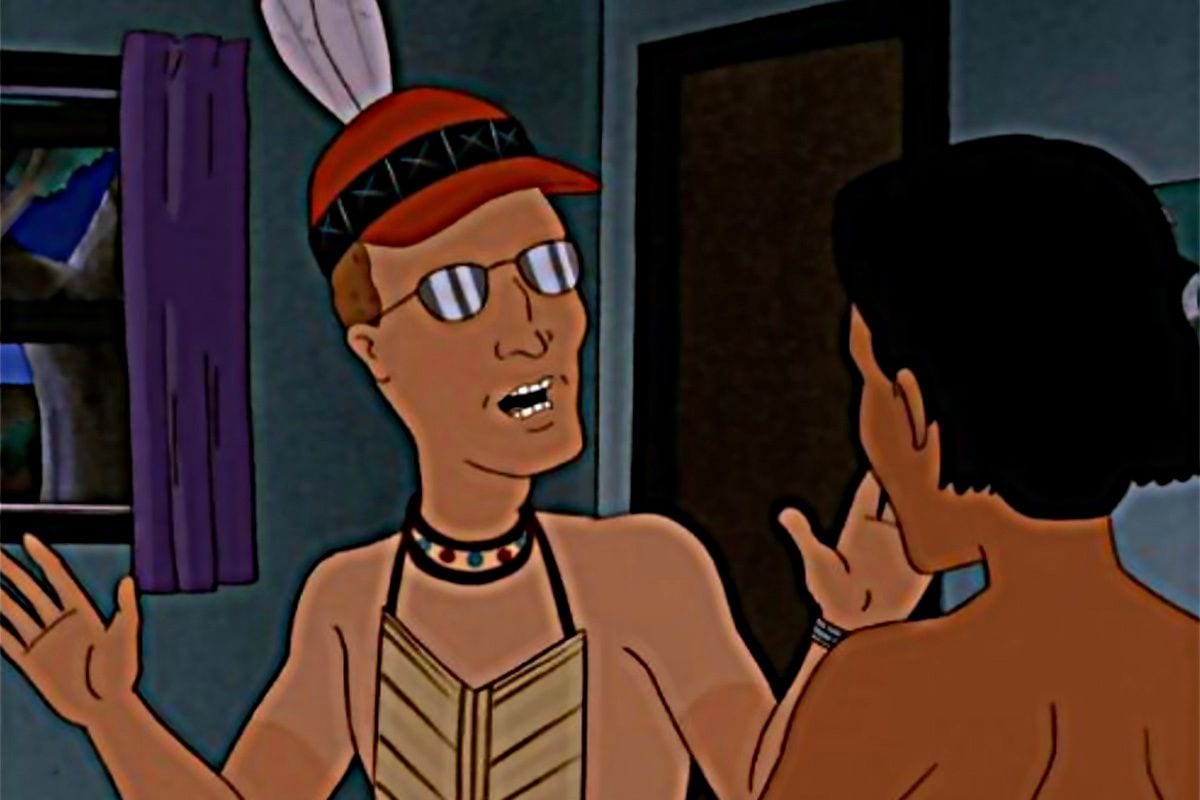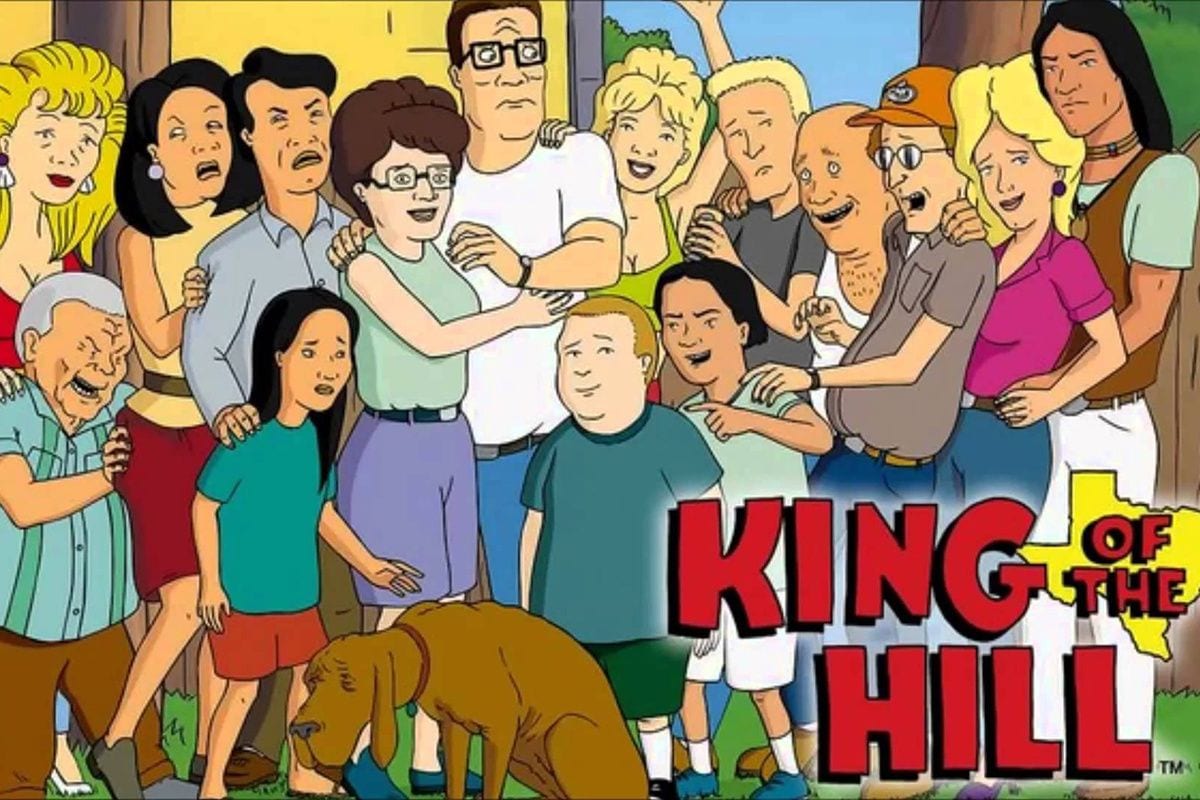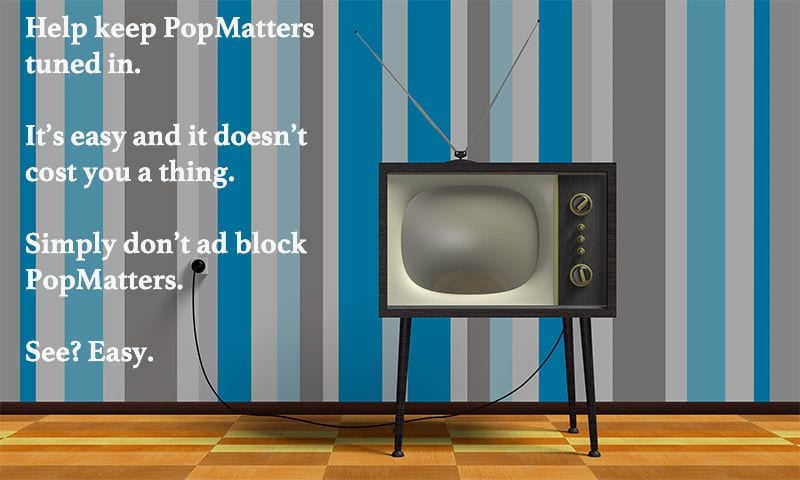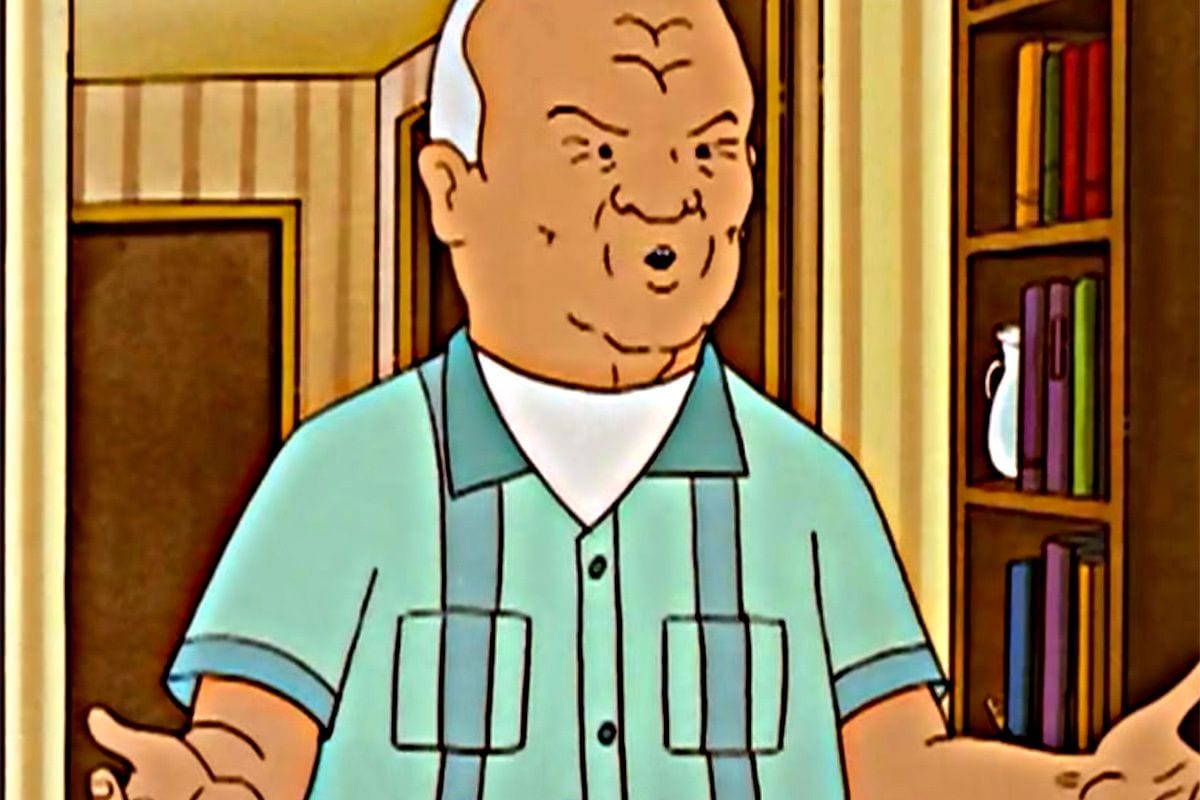TV by AlexAntropov86 (Pixabay License / Pixabay)
In season one, episode seven of King of the Hill, Hank and his buddies notice some new neighbors moving in next door. While at first they incorrectly assume that the white movers are their new neighbors, a look of shock appears on the four friends’ faces when the Souphanousinphones step out of their minivan. Kahn, Minh, and their daughter Connie are ostensibly the first people of color to move into the neighborhood (if the shock experienced by Hank, Bill, Boomhauer and Dale is any indication), leaving the four white friends to wonder if their new Asian-American neighbors are Chinese or Japanese. Even after Kahn explains that they are Laotian American, Hank asks, again, if they are Chinese or Japanese.
Juan Flores examines such generalizations of ethnicity in his essay ‘”Pueblo Pueblo”: Popular Culture in Time’ (From Bomba to Hip-Hop: Puerto Rican Culture and Latino Identity, Columbia University Press, 2000). Flores asks his readers to acknowledge the distinction between an abstract definition of ‘the people’ and a more culturally, historically, and geographically situated description of ‘pueblo pueblo’, or people people, meaning ‘real people’ (76). By insisting upon specificity over generalizations, Flores confronts racist assumptions and ignorance through an emphasis on locating specific peoples in time and space.
Hank Hill’s ignorance of Laotian History, combined with his insular, white, suburban-American experience, allows him to believe that there are only two Asian ethnicities: Chinese and Japanese. Never mind that the former attacked Laos in the 19th century, and the latter occupied Laos in the 20th. Never mind that Laos was colonized twice by the French, and was once occupied by Thailand. Never mind that Kahn and his family are actually Americans who immigrated 20 years before Hank Hill met them.
Hank Hill and his friends see what they’ve been conditioned to see: ‘non-white’ people in a ‘white’ space.
(Cotton Hill character / IMDB)
Hank’s wife Peggy ignorantly props up a similar geographical racism in her interactions with the new Laotian neighbors. While she undoubtedly deserves credit for kindly extending a dinner invitation to the Soupanousinphones, she cooks them Chinese food—the food of the oppressors of Laos—she welcomes them to the United States (again, despite the fact that they’ve been Americans living in California for the past 20 years) and, from afar, she muses: ‘It’s like we get to travel to the Orient without having to worry about diarrhea or being jailed for our pro-democracy beliefs’ (‘Westie Side Story’ 00:02:55-00:03:02).
The Hills, largely unconscious of their status as subjects of a pervasive, racist American ideology, perpetuate and reinforce Anglocentric notions and assumptions regarding the Asian continent in their refusal to acknowledge Kahn, Minh, and Connie’s specific nationality and ethnicity. Arguably more problematic, perhaps even the root of such ignorance, is widespread American ignorance of the histories of specific peoples: of ‘pueblo pueblo’. Flores’ notion of ‘popular culture “in time” calls for historical rather than preponderantly spatial contexts’ (81). By learning the specific histories of ‘pueblo pueblo’, we can perhaps begin to respect and celebrate the difference which Audre Lorde (in her famous speech ‘The Master’s Tools Will Never Dismantle the Master’s House’) calls ‘that raw and powerful connection from which our personal power is forged’ (26). Obscured in the shadows of American ignorance, however, the Hills, despite the fact that they try their best to avoid offense, still see cultural ‘impostors’ in what has historically been a mostly-white neighborhood within a ‘naturally’ Anglo nation.
If racialized bodies are consistently lumped together as an all-encompassing ‘Other’ under a white gaze, how can the Souphanousinphones move from the margins of American culture to a more centralized space in which they are respected as equals? Can the racist ideologies unwittingly preserved by ‘well-meaning’ white Americans be destabilized or escaped? If we resist the comfortable abstraction of the ‘Other’, we can perhaps achieve greater visibility of the granular uniqueness in which each one of us emerges as quintessentially human: situated in particular moments of history, occupying particular pieces of Earth, yet never defined solely by such frameworks.
The White Guilt Paradox
Much later in the series (season seven, episode 20: ‘Racist Dawg’), the Hills hire an African-American repairman named Mack to fix a water heater gas leak which Hank inadvertently caused by attempting to install the new heater himself. As Mack assesses the installation issues, the Hills’ dog, Ladybird, violently growls and eventually attacks the repairman. While at first Mack avoids jumping to any ‘your-dog-is-racist’ conclusions, when Ladybird rolls over and allows the white mailman to rub her belly, Mack is convinced that Lady Bird is indeed ‘full of hate: black hate’ (‘Racist Dawg’ 00:06:12-00:06:14).
While the Hills’ concern and respect for Mack is evident (they invite him to stay for lunch, and in general treat him as an equal), when the larger community learns of canine racism at the Hill residence, the Hills’ initial concern revolves around the status of their reputation within a mostly white community. Peggy complains to Hank: ‘It makes us look like ignorant rednecks’ to which she adds, as an obvious afterthought, ‘and it’s bad for black people too’ (‘Racist Dawg’ 00:10:04-00:10:08). Peggy’s first thought, and the primary source of Hank’s anxiety, stems from the possibility of being viewed as racist by other whites, while the Hills are negligent of and insensitive to the offense taken by the racialized Mack.
The Hills later realize (or convince themselves), when Ladybird displays equal violence toward a white repairman, that their beloved pup isn’t racist at all: she just hates repairmen. However, upon discovering this, the Hills first go to the local reverend (a white woman), to spread the word to the larger community of Arlen, Texas that (hear ye, hear ye!) the Hills are not racist after all! Then, and only then, does Hank take Ladybird over to Mack’s house, to prove that neither Hank nor his dog hold racist views.
Behind and within many of the ‘good intentions’ of ‘well-meaning’ white Americans to extend respect to African-American neighbors and friends lurks an underlying objective to absolve ourselves of white guilt. While an awareness of the structural and historical racism which pervades and continues to define much of dominant American culture is crucially important for white Americans to examine and understand, perhaps more important is an examination of how we continue to marginalize by implicitly asking for forgiveness for the sins of slavery, Jim Crow, incarceration, and endemic, institutionalized injustice.
Ellis Cashmore, in his book The Black Culture Industry, extends a warning against this ‘alleviation of white guilt that Malcolm X once recognized as the bitterly relentless force that drives racism’ (166). The Hills, in their efforts to assuage the symptoms of white guilt, inadvertently augment and solidify the racist hierarchies they desperately try to level. The white obsession with protecting white comfort in ‘white’ spaces, within ‘white’ histories, serves only white people, while sending this message to marginalized peoples: ‘of course you matter, of course you are equal, of course you deserve a voice, but only if I can retain my comfortable position’. Within the ‘well-meaning’ impulses of white guilt lies the fear of a loss of social status, and the ever-present white anxiety of cultural displacement.


Dale and Joseph Gribble characters in “Vision Quest” episode (IMDB)
Appropriating the Culture of the Colonized
The paradoxical focus on white comfort and white feelings within the framework of American race relations is ultra-evident in episode 12 of the seventh season of King of The Hill, entitled ‘Vision Quest’. John Redcorn, a Native American man who lives in a trailer on the outskirts of town, grows increasingly concerned that his son, Joseph Gribble, may be losing touch with his Native American roots. Joseph is being raised to believe that Dale Gribble is his father, despite the fact that Joseph clearly bears resemblance to John Redcorn. Joseph is the result of an ongoing extramarital affair between John Redcorn and Nancy Hicks Gribble, Dale’s wife. Dale genuinely believes Joseph to be his biological offspring, and does not suspect Nancy of any infidelity.
Redcorn, over lunch with Hank, expresses his desire to send Joseph on a vision quest, which he believes will cure Joseph of his recent inclination towards socializing with a mischievous group of older students. Hank, attempting to distance John Redcorn from his son and avoid a public scandal, offers to take Joseph on a vision quest with Dale, to which John Redcorn reluctantly agrees. In an ironic turn, Dale emerges as the one who receives a vision on this quest. Dale begins to hallucinate and declares: “I see the buffalo! I see the Indian! I am the Indian’ (‘Vision Quest’ 00:10:11-00:10:19). Dale begins to believe that he is actually Native American, specifically because he ‘fathered’ a Native American boy. He proceeds to dress himself in Native American clothes and immerse himself in what he believes to be authentic Native American culture.
Throughout the series arc, John Redcorn serves as a representation of the marginalized, colonized Native American population within modern American society: a population which endured unforgivable violence at the hands of European colonizers. Not only does John Redcorn embody the trauma of forgotten genocide, he is the sole Arlen remnant of a colonized people within what many literary theorists have labelled the ‘colonial imaginary’. Emma Pérez, in her essay ‘Queering the Borderlands: The Challenges of Excavating the Invisible and Unheard’, describes the colonial imaginary in terms of the assertion that ‘the United States has been circumscribed by an imagination steeped in unchallenged notions’ (123). She proposes, as a direct challenge to residual racism and colonial ideology, a ‘decolonial imaginary’ which ‘can help us rethink history in a way that makes agency for those on the margins transformative’ (123).
Dale’s appropriation of Native American culture, and his consequent erasure of John Redcorn’s potential influence on his son’s life, expands and fortifies the violence of the colonial imaginary. Not only did white colonizers murder and rape Native American men and women, not only have they historically been dispossessed of nearly all their tribal lands, not only have Native American studies consistently been excluded from the hallowed halls of race theory and academic ethnic studies programs, but dominant American culture has worked persistently to erase the Native American presence altogether.
Further, Dale’s colonization of Native American culture extends even into the personal, domestic sphere: by denying, albeit inadvertently, John Redcorn the right to raise his son, Dale extends the reach of colonial power beyond the cultural, public realm and into the private sphere of the home, into the atomic sphere of the family. With no land, no community, and no son, John Redcorn must continue to endure the pervasive effects of the seemingly indestructible colonial imaginary. Once again, white whims and desires to preserve comfort and status arrest and weaken the decolonial imaginary.
The Subjects of Racism
In Toni Morrison‘s essay ‘Black Matters’, she argues that while the cultural tendency to focus on the ‘exposure of racism and the horrific results on its objects’ (marginalized peoples, racialized bodies) is important, that it may be exponentially more important to explore ‘the impact of racism on those who perpetuate it’ (11). This has been the basis of my analysis of these three episodes of King of The Hill. While it is undoubtedly necessary to listen to and learn about the struggles and triumphs of marginalized peoples, of ‘pueblo pueblo’, my intention above has been to examine and challenge the sources of racism themselves, in hopes to glean some form of understanding about why white Americans perform their guilt in ways that perpetuate the very racism we fear and loathe.
Do Hank and Peggy Hill confront racism by including the Souphanousinphones in their dinnertime ritual and welcoming them as neighbors? Or do they perpetuate ignorance with their refusal to learn about the history and identity of Laotian Americans? Do the Hills really care about Mack’s experience of discrimination, or are they simply seeking forgiveness from those their comfort marginalizes? Does Dale see John Redcorn’s suffering, or is he perpetually blinded by his desire to remain comfortable and powerful within a pervasive patriarchy?
Mike Judge and Greg Daniels of King of The Hill have created a cultural space in which Americans can ask themselves these questions and wrestle with the answers. The show argues for neither easy racial reconciliation nor for the alleviation of white guilt through a convenient ‘we’re all friends’ morality, but simply presents audiences with real Americans in real situations, and leaves the questions to be pondered upon. Stuart Hall, in his essay “What is this ‘Black’ in Black Popular Culture?” argues that ‘it is only the way in which we represent and imagine ourselves that we come to know how we are constituted and who we are’ (291).
The representations of Laotian Americans in Kahn and his family, of African Americans in Mack, and of Native Americans in John Redcorn are crucially important challenges to the colonial imaginary. But the answers to the critical questions of race, posed by the presence of the underrepresented, fall squarely at the feet of the ideological containers of American racism: white people. We must ask ourselves whether our comfort matters more than the voices of the marginalized, and we must examine and challenge the very foundation on which that comfort is built.
Works Cited
Cashmore, Ellis. The Black Culture Industry. London: Routledge, 1997.
Flores, Juan. From Bomba to Hip-Hop: Puerto Rican Culture and Latino Identity. New York: Columbia University Press, 2000.
Hall, Stuart. ‘What is this “Black” in Black Popular Culture?’ Black Popular Culture, edited by Gina Dent. Seattle, WA: Bay Press, 1992.
Daniels, Greg and Mike Judge, creators. King of the Hill. Deedle-Dee Productions, Judgmental Films, and 20th Century Fox Television, 1997.
Lorde, Audre. ‘The Master’s Tools Will Never Dismantle The Master’s House’. This Bridge Called My Back: Writings by Radical Women of Color, edited by Cherríe Moraga and Gloria Anzaldúa. New York: Kitchen Table Press, 1983, pp. 94-101.
Morrison, Toni. ‘Black Matters’. Playing In The Dark: Whiteness and the Literary Imagination. New York: Vintage Books, 1993.
Pérez, Emma. ‘Queering the Borderlands: The Challenges of Excavating the Invisible and Unheard’. Frontiers: A Journal of Women’s Studies. Volume 24, Numbers 2 and 3, 2003, 122-131.



